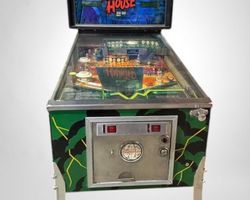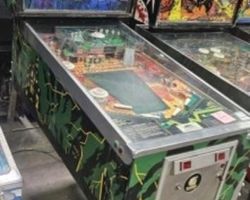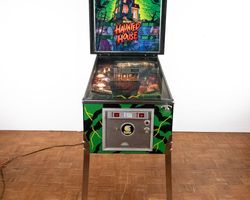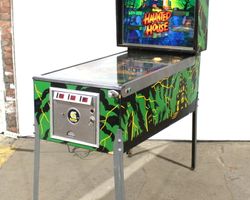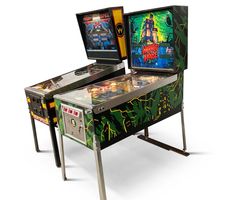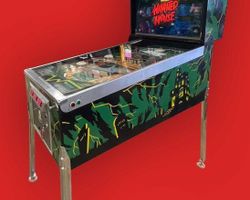Haunted House
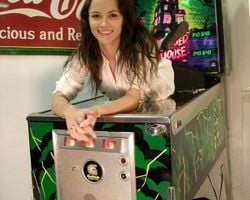
Average Prices: USD $800 to $2,700
Produced: June, 1982
Production Run: 6,835 units
Machine Type: Solid State Electronic
MPU: Gottlieb System 80
Players: 4
Design by: John Osborne
Art by: Terry Doerzaph
D. Gottlieb & Company, a long-standing name in amusement device manufacturing, introduced Haunted House in June 1982. This solid-state electronic (SS) pinball machine, bearing model number 669, was a notable release during the System 80 era for Gottlieb. The machine’s thematic foundation delves into the horror, monster, adventure, and supernatural genres, inviting players into a chilling yet captivating experience. Its inspiration was clearly rooted in classic haunted house tropes, aiming to create an immersive environment within the confines of a wide body pinball cabinet.
The design and production of Haunted House involved a dedicated team. John Osborne was responsible for the machine's overall design, meticulously crafting the layout and mechanical interactions. The distinctive artwork, a critical component of its eerie charm, was a collaborative effort by Richard Tracy and Terry Doerzaph. Their contributions extended across the playfield and the backglass, establishing the machine's signature visual identity. Craig Beierwaltes composed the atmospheric soundscapes, including the memorable organ music, while Allen Edwall developed the software that governed its unique gameplay mechanics. A significant milestone for Haunted House was its groundbreaking introduction of a three-level playfield, a pioneering feature that set it apart from its contemporaries. Furthermore, upon its release, it held the distinction of featuring eight flippers, a record for its time. Gottlieb produced 6,835 units of Haunted House, reflecting a substantial production run for a machine that promised "Triple Playfields Mean Triple Fun!"
Signature Features and Design
Haunted House stands out primarily for its innovative multi-level design. It presents players with a main playfield, an elevated upper playfield, and a subterranean basement level, each contributing to a layered gameplay experience. This architectural complexity necessitates a unique control scheme, requiring players to manage eight flippers strategically positioned across the three levels.
Beyond its multi-level structure, the machine incorporates several distinctive mechanical elements. Gottlieb's exclusive "fat, kicking targets," four of which are present, dynamically propel the ball away upon impact, adding an element of unpredictability. Two vertical up-kickers (VUKs) facilitate seamless ball transport between levels: one elevates the ball from the main playfield to the upper level, and another lifts it from the basement back to the main level. A mechanical trap door, situated under a ramp on the main playfield, opens when a specific light is activated or the ball traverses a lane, allowing the ball to descend into the basement. Another entry point to the cellar is a "secret passage," which is a false target that physically drops down upon impact, revealing an opening. Additionally, a central "swallowing" stand-up target captures the ball and sends it directly to the basement, reinforcing the thematic descent into the haunted dwelling. The backglass enhances the atmosphere with a striking lightning animation, complementing the spooky visuals. A dedicated fifth fluorescent display serves as a bonus counter, which can be multiplied, adding an additional layer to scoring.
Playfield and Mechanics
The playfield of Haunted House is a complex arrangement, designed to exploit its three-level premise. The main playfield, while sometimes perceived as open, provides access to the upper and lower levels. Key shots on this level include the lane leading to the mechanical trap door and the central "swallowing" target, both pathways to the mysterious basement. It also features a 5-bank and a 4-bank of drop targets, along with the unique kicking targets, which challenge players with their unpredictable rebound. The VUK on this level is crucial for transporting the ball to the upper playfield, guiding it into new scoring opportunities. The artwork throughout the main playfield vividly depicts a haunted mansion, complete with spectral figures and eerie details, all illuminated by carefully placed lighting that accentuates the gothic theme.
The upper playfield, accessed via a VUK from the main level, offers a more confined space. While some players find its shots challenging or clunky, it contributes to the overall multi-dimensional feel. This level typically features its own set of targets and opportunities before the ball returns to the main playfield, often through another VUK. The aesthetic continuity of the haunted house theme extends to this elevated area.
The basement playfield is perhaps the most unconventional. It is distinguished by a unique, reversed flipper orientation, forcing players to adapt their usual strategies. Entry to this lowest level is via the trap door or the "swallowing" target from the main playfield. From the basement, a VUK returns the ball to the main playfield, completing the vertical journey through the house. The low-lit, almost claustrophobic atmosphere of the basement, combined with its inverted flippers, creates a distinct and memorable segment of the gameplay experience. Across all three levels, the artwork consistently reinforces the supernatural theme, making the transition between floors a visual as well as mechanical journey.
Gameplay Dynamics
The core gameplay of Haunted House revolves around exploring its three distinct levels and maximizing score through targeted shots and bonus accumulation. The progression is largely non-linear, allowing players to move between the main, upper, and basement playfields based on successful shots and activated mechanisms. A significant aspect of the scoring system involves the "double-bonus" feature available on each playfield. Activating this feature on any of the three levels doubles the bonus points accumulated on that specific floor, encouraging players to strategize their shots and transitions to maximize their end-of-ball bonus. The fifth display serves as a bonus counter, visible throughout play and susceptible to the double-bonus multiplier.
Unique objectives include consistently hitting the "swallowing" target or triggering the trap door to access the basement, which offers a different flipper dynamic and unique scoring opportunities. Successfully navigating the challenging shots on the upper playfield also contributes to score and level progression. While the game's ruleset is considered straightforward and lacks the deep, complex modes found in later machines, its challenge lies in mastering the multi-level flow and adapting to the different flipper sets. For instance, a common strategy involves prioritizing the activation of the double-bonus feature on each level and then focusing on collecting drop targets or hitting the kicking targets for their immediate point values, all while attempting to descend into the basement for its distinct scoring potential. The constant need to be aware of ball position across the three levels and manage the eight flippers makes each game a test of spatial awareness and precise timing.
Reception and Legacy
Haunted House holds a specific position in pinball history, largely acknowledged for its innovative design rather than complex rule sets. The overall sentiment towards the machine is generally positive, with players frequently appreciating its unique features and thematic coherence. Its primary strength lies in its pioneering three-level playfield, which was an ambitious and celebrated design choice at the time of its release. The spooky, haunted house theme is consistently praised for its strong integration, from the captivating backglass artwork with its lightning effect, to the detailed cabinet and playfield visuals. The organ music and sound effects, while occasionally noted for being repetitive, are largely seen as effective in establishing an immersive atmosphere. This thematic consistency, combined with its historical significance as a design landmark, positions Haunted House as a machine recognized for its ambition and contribution to pinball's evolution. Many players find the game engaging for short play sessions, drawn to its distinct architecture.
However, Haunted House is not without its recognized limitations. A common critique centers on its gameplay depth, which many find shallow, lacking the intricate rulesets or prolonged objectives common in more modern designs. Players often feel there is a limited progression beyond simply hitting targets and navigating the levels. Reliability has been another point of discussion, typical of machines from the System 80 line, often requiring consistent maintenance to ensure all mechanisms, particularly the trap door and VUKs, function optimally. The gameplay pace is generally slower than later machines, and the absence of a multiball feature is a frequently cited missed opportunity, with many speculating it could have significantly enhanced the game's energy. Specific elements like the upper playfield are sometimes described as clunky, with awkward shots that disrupt flow, while the main playfield can appear somewhat empty. Despite these points, Haunted House endures as a unique entry in pinball history, influencing subsequent designs that would also experiment with multi-level playfields. Its significance lies in its bold exploration of physical design, cementing its reputation as a distinctive and memorable machine.
Sponsored Links
 Ebay Listings
Ebay Listings
 Auction Results
Auction Results
| Cost | Location | Date |
|---|---|---|
| USD $2,000 |  Missouri, United States Missouri, United States |
27 September, 2025 |
| USD $1,200 |  California, United States California, United States |
24 August, 2025 |
| USD $4,200 |  Illinois, United States Illinois, United States |
03 April, 2025 |
| USD $4,500 |  Indiana, United States Indiana, United States |
24 November, 2024 |
| USD $1,900 |  Illinois, United States Illinois, United States |
15 November, 2024 |
| USD $3,500 |  Virginia, United States Virginia, United States |
12 October, 2024 |
| USD $3,500 |  Illinois, United States Illinois, United States |
05 October, 2024 |
| USD $4,250 |  California, United States California, United States |
10 September, 2024 |
| USD $4,000 |  United States United States |
05 July, 2024 |
| USD $3,000 |  United States United States |
31 May, 2024 |


Private Policy · Search Website · Contact Us
As an eBay Partner, we may earn a commission from qualifying purchases made through links on this site, at no additional cost to you.
All trademarks and copyrighted materials remain property of their respective owners. All other content copyright 2007 - 2025 Pinpedia.

